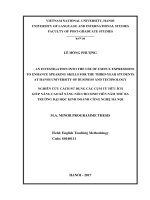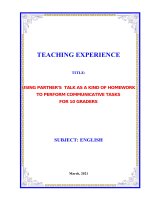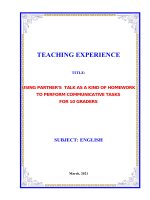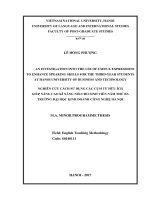skkn cấp tỉnh using ted talks as an extensive listening resource to enhance listening skills for advanced students
Bạn đang xem bản rút gọn của tài liệu. Xem và tải ngay bản đầy đủ của tài liệu tại đây (1.02 MB, 26 trang )
<span class="text_page_counter">Trang 1</span><div class="page_container" data-page="1">
<b>1. INTRODUCTION</b>
<b>1.1. Reasons for choosing the topic</b>
As a language learner, I have found that one of the most difficult skills tocontend with is listening. I was never taught how to listen. It was simply assumed thatlistening skills would be naturally acquired. For my first few years English-as-aforeign-language (EFL) teacher, I assumed the same. However, as I reflected on myown language-learning experiences and those of my students, I rethought thisassumption. I did more research on listening instruction, and,not surprisingly, I learned that listening in a second language is not something that isjust picked up.
According to Thorn (2009), most listening is done for non-listening purposes,such as introducing grammar or vocabulary, for discussion, for testing comprehension(but not actually to learn how to comprehend), and for familiarity with differentaccents. Rarely will someone claim to use listening in class “to train students to listenmore effectively” (Thorn 2009, p.9). According to Brown (2011, p.36), “playing audioand asking comprehension questions, or even playing audio and asking students tocomplete tasks, is merely testing.” Therefore, a great deal of listening practice focuseson testing listening, not teaching it. Testing a skill without first teaching it would notbe acceptable for reading, writing, or speaking, and therefore it should not beacceptable for listening.
When listening instruction does occur, it is mostly a top-down approach. Thorn(2009) again points out that the focus is on schema building, gist, and guessing, notthe words and sounds that actually make listening challenging. Furthermore, thelistening texts themselves often pose a problem— Thorn (2009) believes that mosttexts are uninteresting from the students’ perspective, lack natural language features(e.g., linking or elision), and utilize one standard accent. None of this preparesstudents very well for the real-world listening challenges they will encounter. All ofthese problems are what I experienced during my first three years teaching English asa foreign language. Some of my students at English specialized class, despite havingadvanced grammar knowledge and a wide range of vocabulary, still struggled withlistening exercises or could not listen at advanced level, which corresponded to theirlevels of other skills. It took me a long time to find out that there are several factorsthat impede the listening abilities of my students. The very first reason is limitedexposure to the target language, especially in authentic contexts, which can hinderlistening development. Since English is not the primary language of Viet Nam, thislanguage is often taught as a subject in educational institutions, and students typicallydo not use English as their primary means of communication outside the classroom. Ifstudents do not regularly hear the language, it is challenging to comprehend spokenspeech. Moreover, listening involves processing spoken language in real-time, whichcan be more difficult than reading or writing. It requires quick decoding,
</div><span class="text_page_counter">Trang 2</span><div class="page_container" data-page="2">comprehension, and retention of information. Another crucial factor is how the nativespeakers change word sounds, especially in real-life conversations. For example:“Would you like some coffee?” might sound like: “Wud ch’ya like some coffee?”
<i>(assimilation); “Do you want to see a movie?” might sound like: “Do ya wanna see amovie?” (reduced forms). Even when you are an advanced speaker of English, it can</i>
be difficult to link what you hear to how the words are written . Other factors such asdifferent accents, dialects, and colloquial expressions can further complicateunderstanding. So, how to train students listen more effectively?
Extensive listening (EL) is an approach to teaching listening which can helpstudents develop their listening fluency in a more enjoyable way. However, unlikeextensive reading which has now enjoyed widespread recognition, EL has receivedrelatively little attention, partly because of the limited availability of suitable listeningmaterials. Given the popularity of TED Talks which are freely available online, I wasinterested in exploring this online resource as a source of EL materials for my 10thgrade students at English specialized class, whose English proficiency is at aroundB2+ and C1 level.
<b>1.2. Research purpose and objectives</b>
This study is carried out to meet the following aims:
1. To experiment the applicability of TED Talks in developing grade 10 advancedstudents’ listening skill
2. To measure the impact of TED Talks on grade 10 advanced students’ listening skill
<b>1.3. Research questions</b>
1. What benefits do students get from listening to and watching TED Talks videos?2. What factors are taken into consideration by students when choosing TED Talks astheir extensive listening practice?
<b>1.4. Research Methodology</b>
This section presents the research design as well as research method, datacollection and data analysis. The research context with an overview of Englishspecialized class for grade 10 at Lam Son High School for The Gifted. The researchapproach and method of data analysis are presented later on to provide how to dealwith the research questions and reach the solutions.
In this research, we used multiple data sources: questionnaires, EL journal andan in-depth interview. The questionnaire contained 30 close-ended questions whichfocused on the factors and benefits of doing EL using TED Talks.
Then, the EL journals were administered to three selected students to monitortheir EL practice outside the classroom. The three students were selected based on theresult of the questionnaire in terms of the number of TED Talks videos they hadagreed to watch in two weeks’ time. Schmidt (2016) defined a listening journal as “a
</div><span class="text_page_counter">Trang 3</span><div class="page_container" data-page="3">book in which students record their extensive and intensive listening practices, as wellas reflections on their listening experiences” (p.3). The students wrote on their paper-based journals for a period of 10 days . The journals contained several sectionsincluding, the date, the title of the talks, the length of the talk, the speakers, topics, andaccents of the speakers (see appendix 1). Afterwards, an in-depth interview wasconducted to the same three students focusing on the benefits of doing EL using TEDTalks. The interview data, then, were coded and interpreted based on the emergingthemes.
<b>1.5 Data Analysis Technique</b>
To analyze the questionnaire data, the researcher collated the responses andsummarized these as frequency data. The data from the EL journal and in-depthinterviews were analyzed by using a simple thematic analysis. Thematic analysis is atechnique within information to identify, analyze and report trends (topics). Itminimizes the organization and description of information set in detail (Braun andClarke, 2006). The data mostly contained opinions and perspectives from theparticipants. Then, the transcripts from the in-depth interviews were categorizedaccording to themes that emerged from the data. To ensure the reliability of theanalysis, the researchers used source triangulation and theoretical triangulation(Patton, 2009). The source triangulation was done by examining evidence fromdifferent data sources (questionnaire, interview and journal) of information and usingit to build a coherent justification for the themes. While, the theoretical triangulationwas done by comparing the data with relevant EL constructs from the professionalliterature. In this research, we used Renandya & Farrell’s (2010) construct of EL forour analysis. The researchers also employed intercoder reliability in order to ensurethat there was consistency in the analysis of the data.
<b>2. CONTENTS</b>
<b>2.1. Theoretical background2.1.1. Extensive Listening</b>
<b> Extensive listening can be described as “... all types of listening activities that</b>
allow learners to receive a lot of comprehensible and enjoyable listening input.”(Ivone & Renandya, 2019). Under the context of English language teaching, theconcept of Extensive listening is a comparatively new concept in comparison to its“brother” concept, extensive reading. It is worthwhile to note that listening to itself, asa language skill, receives relatively smaller teaching and research attention, incomparison with other prevalent language skills (Burns & Siegel, 2018). The conceptof extensive listening itself quite possibly started its development from the pre-existing concept of extensive reading (ER). There is also a possibility that it is alsodeveloped from the novel concept of L1 listening (Chang, 2018). Regardless of its
</div><span class="text_page_counter">Trang 4</span><div class="page_container" data-page="4">origin, it is generally agreed that extensive listening is beneficial to the increase oflistening comprehension of its practitioners, as it allows them to adjust their listeningactivities to their preferred type of text, and their specific comprehension needs (Ivone& Renandya, 2019). With the above concepts taken into account, it can easily beconcluded that extensive listening activities involve the act of listening to largeamounts of motivating and engaging materials which are linguistically appropriateover a period of time, in which they listen to materials with a reasonable speed forgeneral understanding (Renandya & Jacobs, 2016). With this, we can determine thatin general, extensive listening is an engaging listening activity where attaining ageneral understanding of what is being spoken serves as the main emphasis and/orfocus of the activity.
<b>2.1.2. Benefits and challenges of Extensive Listening</b>
Numerous benefits of extensive listening have been reported in the professionalliterature on ELT and TESOL. These benefits can be categorized into three mainthemes: (i) improvement of students’ listening fluency, (ii) improvement in listeningcomprehension, and (iii) improvement of other language skills.
In terms of the enhancement of listening fluency, students who listen moreextensively are able to deal with a faster speech rate. Students sometimes cannotcomprehend spoken language simply because the speakers speak too fast. For studentswho have limited exposure to spoken language, speech rates can be one of the hurdlesin developing L2 listening fluency. Renandya and Farrell (2010) suggest that repeatedlistening practice via extensive listening can gradually help L2 learners become moreaccustomed to listen to faster speech rates. The ability to deal with faster speech ratesis believed to be a reliable indicator that students’ listening comprehension skills havedeveloped at a more advanced level (Renandya & Jacobs, 2016).
In terms of overall language comprehension, extensive listening can helpstudents develop a higher degree of familiarity with common language features of thetarget language, which can in turns enable them to experience a higher and deeperlevel of comprehension. EL can help familiarize students with common features ofspoken language such as assimilation, contraction, resyllabification and other forms ofspeech blending. These features, as reported by Renandya & Jacobs (2016), arefrequently found in connected speech and often cause listening problems.
In terms of the effects on other language skills, students who listen a great dealcan develop their vocabulary knowledge. As they listen to a wider variety of topics,
</div><span class="text_page_counter">Trang 5</span><div class="page_container" data-page="5">they become more exposed to a larger range of vocabulary words. Vocabulary wordsencountered in meaningful contexts via listening are more likely to be learned andretained in students’ long-term memory. This way of learning is referred to asincidental vocabulary learning. As Vo (2010) points out "incidental vocabularylearning from extensive listening is an effective way of acquiring vocabulary fromcontext" (p.30). Apart from that, students can also practice their speaking skill. As amatter of fact, in a relaxing manner, they can be more attentive to academic speakingfeatures such as the accurate pronunciation, word stress, and intonation (Vo, 2013).
Another important potential benefit comes from the flexibility and freedom topractice the skill. Because the students are in control, i.e., they select the materialsthey want to listen to, they tend to be more motivated to do more listening on theirown, without any coercion from the teachers. It has been suggested that this type oflistening is more likely to facilitate language acquisition.
</div><span class="text_page_counter">Trang 6</span><div class="page_container" data-page="6">Despite the numerous language learning benefits discussed above, a number ofL2 listening researchers have voiced their concerns. Vandergrift & Goh (2012) forexample maintain that EL alone is not sufficient to help L2 learners achieve higherlistening proficiency. They suggest that a set of carefully chosen cognitive andmetacognitive listening strategies can and should be taught to help students becomebetter listeners, in particular when they are listening to academic texts or other texttypes that tend to be content-heavy. We agree with them that EL and IL (whereteachers focus more on teaching listening strategies) can go hand in hand and supportstudents’ listening abilities.
<b>2.1.3. TED Talks for Extensive Listening</b>
Teachers can now use publicly available listening materials on the internet,thanks to technological advancements. The TED series has established itself as one ofthe most popular websites for giving presentation-based videos to global audiences.TED stands for Technology, Entertainment, and Design. Since 2006, TED Talks havebeen made available on the TED website. There have been some studies involving theuse of TED Talks in extensive listening. Takaesu (2017), for example, reported usingTED Talks to teach his college EAP (English for Academic Purpose) students whoseproficiency levels were quite varied. About 78% of the higher proficiency students feltthat the use of TED Talks for extensive listening improved their listening skills.Nearly an equal number of the lower proficiency students (74%) reportedimprovements in their listening skills. This showed that even though TED Talk videopodcast is a novel media, it is effective in supporting extensive listening practiceamong language learners.
According to Park and Cha (2013), there are several benefits of using TEDTalk videos. First, TED Talk videos are interesting because they include a wide rangeof topics such as technology, entertainment, design, business, science, and globalissues (Nurmukhamedov, 2017). Secondly, TED Talks have a distinctive "interactivetranscript" feature embedded in each talk. The combination of reading whilelistening/viewing to video materials is a pleasantly rewarding experience. It canenhance students’ motivation and comprehension of the listening materials as well.
Thirdly, TED videos are sharable. Learners can easily share the links usingsocial media or download them as offline contents. Besides being sharable, TED Talksare also searchable “in multiple ways, including by speaker, subject, or theme” (Loya& Klemm, 2016). This aspect gives the listeners flexibility in finding topics of theirinterest. Lastly, TED Talks can be accessed at any time and any place as long as one isconnected to the Internet. Any mobile devices such as tablets, smart phones, laptops,or computers can access TED Talks without any limit. TED Talks can also motivateand inspire students to have the eagerness to learn on their own, thus promoting self-directed and independent learning in our students (Rubenstein, 2012).
</div><span class="text_page_counter">Trang 7</span><div class="page_container" data-page="7"><b>2.1.4. Listening Journals</b>
The research suggests a clear and desired need for a stronger intensive andextensive approach to listening instruction. Not only do students need to do morelistening, but they need to do this listening in conjunction with an approach that helpsthem focus on sounds, words, and building meaning from the bottom up as well as thetop down. Listening journals are one tool I have used to serve these needs.
A listening journal is a book in which students record their extensive andintensive listening practices, as well as reflections on their listening experiences. Theextensive listening aspect of listening journals requires students to choose and listen totexts that appeal to them from a source provided by the teacher. Students typicallylisten to a text several times while focusing on meaning. It is recommended that theselected texts have subtitles or transcripts for follow-up intensive activities. Thesetexts are often authentic media from websites like ted.com, although for lower levelsthere are many options for media made specifically for language learners, such asNewsInLevels.com and FluentU.com (see www.anthonyteacher. com/listening-resources for a full list of sources).
Moving from extensive listening to intensive practice, students take these textsand focus on decoding or other related skills in order to train their listening abilities.Popular and effective activities in this area include completing gap fills andtranscriptions; however, prosody marking and pronunciation activities are also useful.Finally, students reflect on their successes, strengths, and weaknesses in order toidentify skills they need to improve. Strengthening these weaker skills becomes a goalfor students to focus on during further listening practice in the classroom, outside theclassroom, or in subsequent listening journals. All these activities are recorded in thelistening journal and submitted once a week. For example, a website and series ofactivities are introduced and demonstrated on Monday; students choose a video fromthat website and complete the template, and then the students’ work is collected thefollowing Monday. Each week, the source and activity can remain the same or bechanged. Listening journals can be handwritten in a notebook or follow a premadetemplate. Templates can be tailored for specific activities, or they can be generaltemplates suitable for any activity Another way to use listening journals is to provide asmall book, or packet, of journal templates at the beginning of the course, along with anumber of websites appropriate for the students’ level, and providing a quickdemonstration of each site and activity. Students visit anyof the sites each week and select and listen to a video of their choice. For any video,they should follow the same activities, which include meaning-based listeningfollowed by intensive listening activities. Students complete these journals on theirown time and submit their book or packet several times throughout the course. (seeAppendix 1 for Listening Journal Template for TED Talk Activities)
</div><span class="text_page_counter">Trang 8</span><div class="page_container" data-page="8"><b>2.2. PRACTICAL BACKGROUND</b>
In this section, we present the results by first reporting on students’ perceptionsabout the factors that affected their choice of TED Talks and the perceived benefits ofTED materials for their independent extensive listening/viewing activities in and outof the classrooms.
<b>2.2.1. Factors Affecting the Selection of TED Talks for EL </b>
According to Takaesu (2017) and Renandya and Farrell (2010), students normallyconsider six factors when selecting listening materials, i.e., length, speaker, topic,accent, speed, and vocabulary complexity. The results provided data about students’opinions related to those factors, as can be seen in Figure 1 below.
<small>Speaker Speed Vocabulary </small>
<small>Complexity </small> <sup>Genre</sup> <sup>Accent </sup> <sup>Length</sup><small>60.00%</small>
<b>Native or Non-Native English Speakers. </b>
As can be seen, speaker factor ranked first with a large number of students(82.86%) selecting this option in the questionnaire. The TED Talk speakers in thisresearch refer to native English speakers (NES) and non-native English speakers(NNES). Students prefer to listen to TED Talk videos delivered by NES (54.79%)rather than those delivered by NNES (45.21%), although the difference is relativelysmall. This means that students in our study are more likely to watch videos deliveredby native speakers of English (see Figure 2).
</div><span class="text_page_counter">Trang 9</span><div class="page_container" data-page="9"><b>Figure 2. Speakers' preference</b>
In a follow-up interview, two students reported that their preference for NESs
<i>was due to practical considerations. Respondent Y explained, “... of course I’ll choose</i>
<i>native English speakers because besides native English speakers, for example Thai orKorean, their English are not clear”. They felt that native speakers spoke with greater</i>
accuracy and clarity, which better facilitated their comprehension of the contents ofthe talks.
<b>Speed</b>
</div><span class="text_page_counter">Trang 10</span><div class="page_container" data-page="10">Speed or speech rate ranked second with 80.00% of the students reporting thisas a key consideration. According to Renandya and Farrell (2010), faster speech ratescan have a negative impact on students’ comprehension. Not surprisingly, 58.47% ofthe students agreed that they liked to listen to TED Talk videos which had a slowerspeech rate; however, 41.53% of the students felt that a faster rate was not a majorconcern. This data seems to suggest that even though students liked to listen to NESs,they favored NESs who spoke with the ‘right’ speed. Figure 3 and Table 3 belowdisplay the speech rates of the TED Talk videos the students had difficulty with.
<small>Slower Speech Rate58%Faster Speech Rate</small>
<b>Figure 3. Speed Reference</b>
<small>Slower Speech RateFaster Speech Rate</small>
EFL students’ listening comprehension seems optimal at 127 words per minute.This suggests EFL students are more likely to encounter difficulties in listening if thespeech rate is above 127 wpm (Buck, 2001 as cited in Blyth, 2012). In this study,students seemed to be struggling when listening to TED Talks with a speech ratefaster than 127 wpm. As can be seen in Table 3 below, respondents Y and G hadproblems with fast speech rates. Respondent P, however, did not seem to haveproblems with speech rates. It is possible that P might have developed a higher levelof listening fluency compared to Y and G.
<b>Table 3. Speech Rate Data Analysis from the EL JournalsRespondentNumber of</b>
<b>Difficult Video<sup>Speech Rate for </sup>Good Comprehension (wpm)</b>
<b>Speech Rate in The Video (wpm)</b>
<b>Level of Difficulty</b>
difficult
</div><span class="text_page_counter">Trang 11</span><div class="page_container" data-page="11"><b>Vocabulary Complexity</b>
A sizable number of students (80%) felt that the vocabulary load of the talks influenced their choice of TED materials. Approximately 59.28% of students chose TED Talks that contained simpler vocabulary words rather than the more complex ones (40.72%). The division of these criteria were formulated on students’ viewpoints notably for their familiarity with the words contained in the TED videos. It is believedthat comprehension may be difficult if the text contains more than 10% of unfamiliar vocabulary words or (Nurmukhamedov, 2017).
<small>Complex lary41%</small>
<small>Vocabu-Simple Vocabulary59%</small>
<b>Figure 4. Vocabulary Complexity Reference</b>
Data from the three students who kept the journals showed that they preferredwatching TED Talks that contained simple to moderate levels of vocabulary difficulty.As can be seen in Table 4 below, these three students chose to watch TED Talkspresented in simple language. This is not surprising as the proficiency levels of theparticipants in the study were mostly in the B1-B2 range on CEFR.
<b>Table 4. Vocabulary Data Analysis from the EL Journals</b>
<b>RespondentNumber of Video Based on Its Vocabulary Range</b>
</div><span class="text_page_counter">Trang 12</span><div class="page_container" data-page="12">It is worth noting that the TED website does not provide information about thedifficulty levels of the videos. To help students choose TED Talks that match theirlevels of proficiency, we suggest that teachers could provide students with a list ofTED materials that have been pre-selected based on their levels of difficulty. Thegrading can be first done by the teacher and later adjusted based on input from thestudents.
According to the data in figure 1, topic ranked fourth with the percentage of79.29%. The questionnaire data shows that 51.66% students agreed that they listenedto non-educational TED Talks more than the educational ones (48.34%). It isencouraging to see that students seem to be listening to a wide variety of topics.Research shows that wide listening can in the long run increase students’ worldknowledge and in turns help their oral comprehension (Zeeland & Schmitt, 2013).
<b>Figure 5. Topic Preference </b>
<b>Table 5. Topic Data Analysis from the EL Journals</b>
<b>Respondent Y Selected Video Topics</b>
Education Psychology Entertainment Science
<b>Respondent P Selected Video Topics</b>
Sport Environment Psychology
<b>Respondent G Selected Video Topics</b>
Technology Education Science Entertainment Psychology
From the questionnaire results in figure 5 and EL journal results in table 5above, students’ topic preference seems to be dictated by their personal interests.However, in general students seem to prefer watching non-educational topics such as
</div><span class="text_page_counter">Trang 13</span><div class="page_container" data-page="13">sports, entertainment, technology etc. Only two respondents listened to twoeducational TED Talk videos. Respondent Y was more interested in watching recentnews from the youth and science categories. Respondent P indicated that he was moreinterested in the environmental themed TED Talks. He said, “I like watching videoson the environment. The speakers usually talk about things that happen around us, soit is more realistic". Respondent G was more interested in technology. He said that “...When I watch TED Talk videos on technology, we can take the benefits from thosetechnology or how they invented it". As Zeeland & Schmitt (2013) pointed outlistening passages from various genres provide a wider variety of input rather than justinput related to academic topics, thus exposing students to far richer language input.
Figure 1 shows that accent ranked fifth with 72.86% of the students choosingthis option. From the questionnaire responses, students tended to agree that theypreferred to listen to TED Talk videos by speakers with a North American accent(37.98%), and British accent (32.06%), whereas about one third (32.06%) indicatedthat they had no issues listening to people with non-UK and US accents. Respondent
<i>G commented "American (north) accent was more comprehensible than the others.</i>
<i>Sometimes, if I listen to other accents than American (north), what I listen is differentwith what they say". Siregar (2010) reported that her Indonesian students also found,</i>
American English (AE) to be more comprehensible in terms of the accent andpronunciation. Nonetheless, respondent Y and P said that they would listen to TEDTalks delivered by speakers with a British accent only because of its interestingmanner of speaking even though the talks may not be too comprehensible to them.
<small>No Preference 31%</small>
<small>North American37%British</small>
</div>








